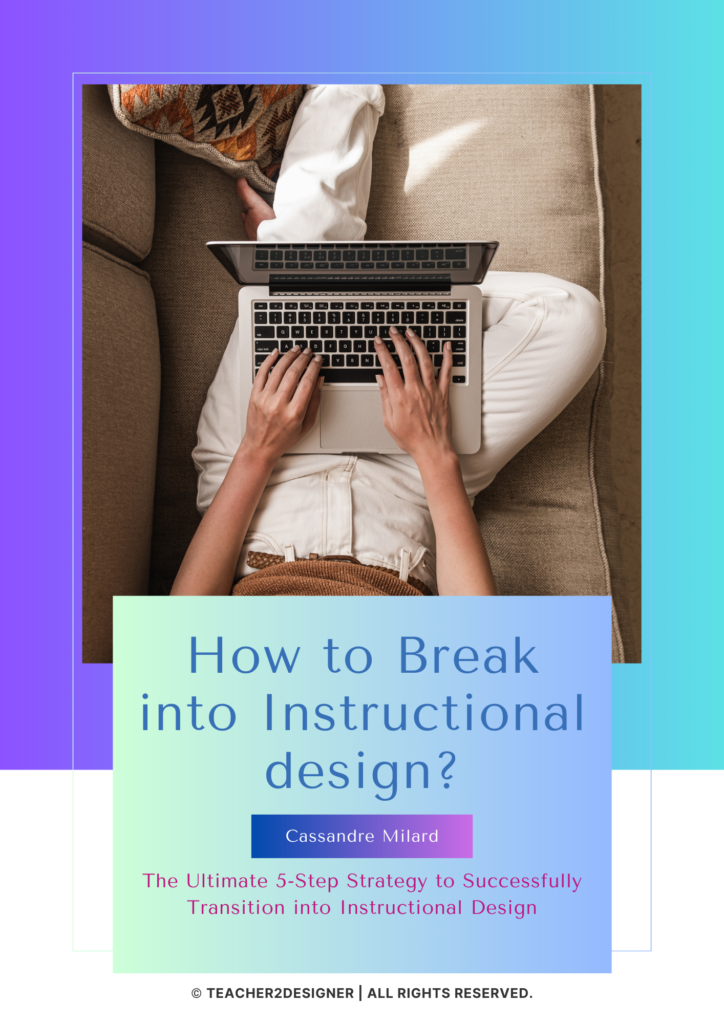For those new to the world of instructional design, eLearning, or learning and development in general, it can be overwhelming to understand what instructional design is and the various tasks that instructional designers perform on a day-to-day and project-by-project basis. And if you, like many others in this industry, stumbled into instructional design by chance – just like I did over two years ago – it’s normal to feel confused by the differing answers and opinions that you might come across.
Many instructional designers define instructional design differently. This is because there are no set standards in our industry. Instructional design varies depending on your organization, the learners you serve, and the training experiences you’re designing and developing. If you are new to instructional design or considering it as a career, this post will help you understand what instructional design is practically and straightforwardly.
How would I define Instructional Design?
Instructional design is the process of designing and developing effective training experiences or resources based on solid learning theories. The goal is to improve performance and deliver results back to the organization. However, despite its simplicity, there are many different answers and opinions about what instructional design really is. This is because the industry tends to overcomplicate things. It’s important to understand that how one defines instructional design depends on one’s perspective, either from the theories or the instructional design processes.
Those formally educated in learning and education often see instructional design as a set of theories that guide us in designing engaging and effective learning experiences. On the other hand, those who fell into instructional design by accident—as I did just a few years ago—view instructional design as a set of processes that help us develop training experiences in a repeatable and scalable way.
Instructional design can be confusing to define due to the duality between theory and process, design and development, and learning and training. However, both aspects are necessary for effective instructional design. The theories of instructional design are only helpful when paired with effective processes to solve real-world performance issues. To better understand instructional design, let’s examine both the theoretical and practical elements in more detail.
Instructional Design Theories
While many different theories underpin everything we do as instructional designers, if you’re new to instructional design and eLearning development, the following are the most commonly referenced ones:
- Malcolm Knowles’ Principles of Adult Learning, which helps us create training experiences optimized for adult learners
- Merrill’s Principles of Instruction, which helps us design task-based training experiences to help learners solve real-world problems
- John Sweller’s Cognitive Load Theory, helps us avoid overloading our learners with too much cognitive processing of information
It is important to note that when we consider instructional design from a theoretical standpoint, we do so independently of the method used to deliver the training experience. This means that we apply these theories to every learning and training experience, whether it is synchronous training like an instructor-led workshop, an asynchronous experience like a self-paced eLearning course, or a fully blended training solution. The same theories are used for all types of training experiences.
Instructional Design Process
Now that we understand the theories behind instructional design, let’s examine the process of creating a training solution. Understanding the theories alone is not enough; you must also know how to apply them when developing a training program. The practical aspects of instructional design become apparent when we move away from theory and focus on creating a learning solution.
As an instructional designer, you’ll carry out a variety of tasks every day and for each project. However, there’s much more to the process than these tasks alone:
- Conduct needs analyses to identify the root cause of a performance issue and determine if training can address it
- Collaborate with stakeholders and subject matter experts to scope and manage their training projects.
- Create action maps ensuring training efforts towards measurable business goals.
- Write performance-based learning objectives.
- Draft design documents to propose blended training solutions.
- Develop training materials as simple as a job aid or as complex as an eLearning course.
- Draft storyboards and develop prototypes in various eLearning authoring tools like Articulate Storyline, Rise, etc.
- Implement and measure those training solutions that are delivered to learners
Instructional design is a complex process that involves many factors. It is essential to understand that instructional design processes are specific to the mode of delivery. This means you must consider various variables related to your learners, their learning environment, your instructional content, and the project you are working on. This will help you determine the best method for developing and delivering the training experience, whether a small or large-scale training solution.
And when we talk about the process side of instructional design, we start looking at models like ADDIE or SAM, which provide us with a framework for executing these processes in a repeatable and scalable way. Lastly, it’s important to mention that the instructional design processes can vary from team to team, depending on the scope of work and how the team is structured.

Ready To Jump Into Your Transition?
Here is how I can help 🙂
- Grab a copy of my free e-book: If you are new to instructional design or eLearning, this guide will direct you through the initial steps in preparation for your exit plan.
- Book a 1:1 Call : Do you need help navigating your skillset or career development? Schedule a call to discuss your current situation, goals, and how to bridge the gap between them.
- Join the Teacher2Designer Accelerator Program: Looking to learn instructional design, master eLearning development, and build your portfolio with Articulate Storyline? Our program offers personal support and feedback to guide through this transition.




